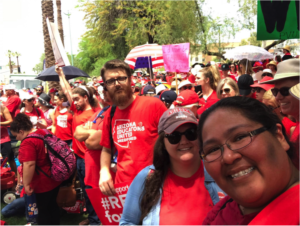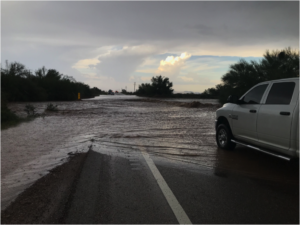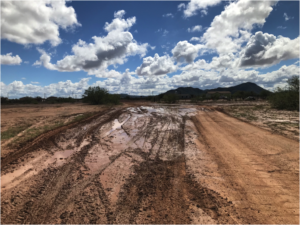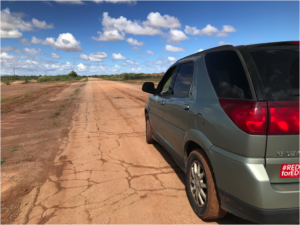I am one of the 75,000 public school educators who marched to the Arizona State Capitol on a 101 degree day in April 2018 to demand an increase in statewide funding.[1] I am also a proud member of the Tohono O’odham Nation, and a College and Career Readiness Counselor at a school on our reservation in southern Arizona.

When I am in non-Native spaces I often hear things like, “I have never met a Native American before,” so I am very aware that people were floored to learn that not only do we still exist, but that we also send our children to Arizona public schools. In the United States there are more than 573 distinct Tribal Nations.[2] In Arizona, twenty-two Nations have reservations, making up nearly 25 percent of Arizona’s lands.[3] Natives from other nations throughout the country are also represented in Arizona, as we are no longer legally bound to reservations, as we were when they were first established. In short, there are a lot of Native Americans in this state.
Some of the challenges we face in schools on the reservation are common to all Arizona schools. Arizona consistently ranks among the states with the lowest per-pupil spending, and the lack of resources limits our ability to provide our students with a quality education.[4] Although I am one of the extremely rare teachers who are paid a living wage in Arizona, I am still burdened with outrageously high healthcare costs, transportation costs and of course, the cost of supplementing classroom supplies. The dedicated colleagues I work alongside and depend on everyday including the bus drivers, paraprofessionals, cafeteria workers, facility and maintenance crew, and front office staff are still struggling to make ends meet.
However, my site is pretty unique and therefore we have unique needs.[5] My school is 99 percent Native American, largely serving members of the Tohono O'odham Nation, though other Native Nations are represented in our student body. We are located on a reservation that is nearly the size of Connecticut. My school is located only twenty miles from the U.S.-Mexico border and we struggle with dirt roads, extreme weather conditions, and the constant presence of the Border Patrol. Our school district also struggles with issues associated with low socio-economic conditions, historical trauma, and lack of culture competency due to low teacher retention.
Transportation
On the main part of my reservation, there are only three main high schools. One high school serves the west end of the reservation and two others are located more centrally. Students may ride the bus for one, two or sometimes three hours just to get to school, one way. If a student participates in extracurricular activities, they may leave before the sun rises and return well after it has set. Transportation is one of the largest issues that our school deals with on a daily basis.
Our school receives “Impact Aid”; federal dollars which are supplemented to schools in rural areas that don’t generate enough in property taxes to sustain the cost of transportation, but it is not enough to meet all our needs. In my school district, our amazing bus drivers maintain a split-shift in order to get the children to and from school. They work in the early morning, they clock out for several hours, then they clock back in later in the day. Their days are extremely long and they often drive in harsh and sometimes extreme and dangerous conditions.
Heat
Arizona temperatures hover in the high 90s by the end of the school year. Our children experience triple digit bus rides in July when the school year starts again. A common complaint for many years has been inadequate cooling systems on our buses. Although people may say that it is a minor inconvenience, when forced to travel an hour or more to reach home, in a vehicle that traps heat and can reach high internal temperatures, that heat then becomes a serious health and wellness issue.
There is little data on the internal temperature of slow-moving school buses traveling down bumpy dirt roads with a broken air-conditioning unit. A common anecdotal complaint from parents is that their children sometimes return home covered in sweat, lethargic, and dehydrated from a long bus drive. It is not an exaggeration to say that an underfunded transportation system puts a toll on the bodies of our students.
Flooding
In July and well into August, our region is also subject to extreme weather and flash flooding. Rainstorms usually occur in our region only twice per year; in the summer and winter. Culturally, the summer monsoon rains mark the beginning of the O’odham New Year and are preceded by saguaro fruit harvesting and a ceremony to “sing down the rain.” Rain is considered a great blessing and is highly anticipated and celebrated.
However, the desert soil cannot absorb the downpour of rain fast enough, so the result is running washes. Washes are large bodies of swift, running water that form in the dips in the roadways. They can be 3–4 feet high and 30–50 feet wide and take hours to recede. As little as only one foot of water is dangerous to cross and has the power to lift one’s tires off the road.

When heavy rain is forecasted, schools and employers often release people who live in the more rural villages, in hopes that they can avoid being stuck all night on a roadway. Sometimes they make it home before the storm hits, sometimes they do not. O’odham are accustomed to sitting on the sides of roads, waiting for the washes to go down, so they can get to their homes. People are often stuck waiting for hours. It is common to see social media updates about which washes are running, how long people have been waiting for them to go down and when they are finally low enough to risk driving through.
In July 2018, one bus driver in our school district waited to cross such a wash with nineteen students in his care until after 10:00 at night. Luckily, they were stuck by a tribally-run nursing home, and the school district arranged for them to provide the children with sack lunches as they waited to go home. The kids ranged in grade from Kindergarten to high school. It took the children seven hours to get home from school that day, even though they were released early. The bus driver—who did not receive hazard pay—had an even longer day.
The next morning, my classroom attendance was at nearly 50 percent. My students had low energy. They were not complaining at all, because these transportation issues are normal for them, but I noticed in the attendance notes that many families called to excuse their children from school, citing muddy roads as the reason.
It is standard protocol on rainy days for the bus drivers to drop off students “on the blacktop only,” which means parents have to meet the bus by the main roads, otherwise the heavy bus would likely sink into the mud and get stuck. Some have to walk through the muddy areas because their personal vehicles are also at risk of getting stuck. Some families who live far off dirt roads are essentially trapped at home until the roads dry out.


Poverty and Housing
A 2016 Community Profile document states that “Tohono O’odham Nation families have a significantly high poverty rate (37.7 percent) and an unemployment rate of 24.6 percent, compared to the 9.7 percent unemployment rate for the United States as a whole.”[6] There are very few job opportunities and generational poverty has created conditions that often keep families from climbing out of their situations.
Many tribal members struggle with housing needs. We have a housing shortage and many families struggle with this regardless of income. It is literally not possible to simply decide to rent an apartment anywhere on our reservation. The only vacant homes are crumbling and beyond repair. Housing applications sit waiting for years, sometimes causing multiple generations of families to crowd into a single home. In recent years, there have been great strides in housing construction and many families moving into newly constructed homes that they started the paperwork for 10–15 years ago.
Teacher Retention
We struggle to retain teachers in our school district. The distance from a major city is a definite drawback for those accustomed to urban living. The school district maintains its own teacher housing units, which are limited and in high demand. There is only one grocery store for fifty miles, the price of food is raised to compensate for the expense in transporting and relatively low volume of sales. There are only a handful of restaurant and fast-food options in our community at all. Gas prices can be as much as a dollar more per gallon on the reservation, again to compensate for transporting fuel. Internet services are undependable and there are very few options for entertainment throughout the week. For those, like myself, who commute every day, there is a teacher bus that shuttles faculty, staff and a few students back and forth to Tucson every day. Tucson is the nearest, large city, which is about 50 miles from our schools. If we are lucky, we can get back to Tucson around 5:30 at night, before driving to our homes. Many teachers utilize the spotty WiFi on the bus to work, and often you see people creating PowerPoints or grading papers as the bus bumps along the highway, but it is not possible when the bus is full and you’re sharing a seat.
I often describe the commute as, “an uncomfortable nap to and from work” as people react in shock after learning about how much I travel in a week. I spend over twelve hours away from home simply working on the reservation. I personally think the commute is a small price to pay for being able to work with members of my own Tribe. However, many teachers cannot sustain the commute or their family situation does not allow them to stay. Even though the pay is higher than average at $51,000 per year for teachers with bachelor’s degrees and zero experience, we have a high rate of turnover and teachers eventually go back to live off reservation.
Non-Native teachers struggle to adjust to the culture and sometimes find that tactics that work in urban schools do not work on our students. Many populations see a clear path of empowerment through education, and of course, that’s now true in Native American communities, but we are also still dealing with the effects of historical trauma. Where other populations may have been denied an education as a means of oppression, education was used as the very tool for oppression for Native Americans. The mantra, “kill the savage, save the man” was an assimilation tactic deployed by the US Government, largely carried out by missionaries.[7] The tactic was specifically designed to block Native American children from speaking their language or participating in their culture.[8] Children were often forcibly taken from their families, assigned names, and had their hair cut short and their traditional clothing thrown away.[9] Many of these children were abused for speaking their traditional language.[10] They were separated from their families and there are countless accounts of sadistic abuse, sexual abuse, illness and death.[11] School was not a place for enlightenment and empowerment for many of our elders, it was a place of hurt and pain. Although attitudes towards education are changing, these traumas still exist within our communities and may explain low parent involvement in our schools.
Even now, we are undoing the damage of historical trauma inflicted by the United States governments’ abusive educational practices on Native Americans. It is imperative that we acknowledge and celebrate the students’ cultural beliefs, values, and teachings that come from their homes and communities. However, the few cultural teachers that are hired at each site must research and develop all their own resources, on top of developing their own curriculum. There is only one dictionary written in our language, which uses an unconventional writing system that differs from the official writing system of our tribe. Therefore, words that are found in that dictionary, must be converted into the standard writing system before use. This additional step creates much confusion and inconsistencies in resources. Normally, dictionaries are written by linguists and others who research and study language. They are not usually written by teachers in classrooms, who have other job responsibilities. For context, that would be like a Spanish teacher needing to create the standard curriculum, create materials, teach and manage their classrooms, engage with parents, receive professional development, and other assigned duties such as lunch duty or club sponsor, but on top of all that also needing to create the dictionary or grammar book needed for their content area. Materials are often created but not made available to others and are not formalized in any way. Because of this, they are often recreated over and over and are unavailable to each new culture teacher. The demand placed on our cultural teachers to then provide resources or formal or informal cultural professional development for the non-Native teachers is high and creates a burden. We simply do not have the resources available to culturally prepare our non-Native teachers and our students often suffer as new teachers navigate their way through our community.
When the walkouts were announced, the teachers at our school did not know what to do. Many felt we did not have the right to walk out because our paychecks are much higher than that of other Arizona educators. That being said, many teachers have expressed how much they are burdened with student loan debt and the high cost of insurance premiums and even at the $51,000 starting pay, are still struggling to thrive. In addition, much of our conversation centered around the positive change we want to see in the schools. The more we discussed the things that were wrong in our schools and how much that impacted our students and our community, the more we realized that we absolutely belonged at those actions.
Receiving more funding in a community like ours not only makes a gigantic impact on our campus, it would make an enormous impact in the surrounding community as well. Because we struggle to recruit and retain teachers, we rely heavily on our classified staff. I am one of only a handful of Native American teachers and an even smaller representation of Tohono O'odham educators in my entire school district. The majority of our certified staff are non-Native, but the majority of our classified staff are Tohono O'odham. Classified staff members are paid much less than certified staff members, which means that we are paying our Tohono O'odham staff members far less than our non-Native staff in their own community. Not only are we failing to pay our classified staff enough money to thrive, we are also unconsciously herding our children into a specific classification of employment that will continue the cycle of poverty and struggle.
The classified staff are most often members of the community who do not hold bachelor’s degrees. More funding districtwide would allow for our school district to invest in long-term, meaningful teacher or professional retention programs such as “grow your own” models. Grow your own initiatives build on an individual’s already established dedication to their own community and provide them with the financial, academic, and emotional support they need to complete an academic or professional program. These individuals, having grown up in our same communities, with the same cultural understandings as our children would have an advantage when trying to connect with our students. They are also less likely to leave because they already have established roots and a vested interest in the progress of the community. Programs such as these have the power to develop a bus aid into a bus driver or a classroom aid into a classroom teacher. The positive aspect of that progression also shows the educational and economic opportunities for our students, who then have role models that look like them and come from their same communities. Economically, this would also provide more jobs with meaningful pay for families and boost the local economy by keeping wages earned in our community, rather than commuting back daily to Tucson.
Further funding could be invested in long-term construction projects such as building repair, maintenance, and new construction. We have been challenged with leaking roofs, mold, unsafe playground equipment, inadequate storage, inefficient spaces, lack of recreation areas, and an accumulation of general wear and tear that always seems to be kicked down the road. The bus drivers who drive in extreme weather conditions have been waiting for a dedicated lounge for many years and are currently in a makeshift lounge that is uncomfortable and unwelcoming. The teacher housing units are all in need of repair and refurbishing and there are not enough units to house newly recruited teachers.
The need for transportation funding goes without saying. We need to buy new buses that are reliable and can safely deliver our students to our most rural communities. Adequate heating and cooling systems on all buses, no matter how long the route should be standardized. It is also essential that we adequately train and pay our bus drivers and bus aids for working in hazardous conditions. Hiring incentives for potential bus drivers and bus aids would also help with recruitment.
Ideally, funding would go towards developing our cultural content. It is absurd to expect cultural teachers to design every aspect of their own materials on top of their regular duties while constantly providing cultural competency training and support to their peers. A dedicated line of funding could go towards hiring additional staff to develop permanent materials that could be used every year across multiple classrooms. Staff dedicated to the cultural competency of non-Native teachers could provide more meaningful professional development, which translates to classrooms where the student feels more understood, valued, and respected.
Education funding needs in Arizona are incredible. My site needs more counselors, diversion programs, extracurricular activities, an emphasis on the arts, life skills education, emotional and relationship skills education, better school lunch programs, updated technology, and basic classroom materials, just like every other school in the state. In addition, being a 100 percent Native American School located in a rural location adds in additional needs that the state of Arizona absolutely has a responsibility to provide. I believe that my colleagues, both certified and classified, deserve to be able to take care of their families.
I love my community.
I believe in my students.
I know we deserve good things.
I am proud to call myself a #RedForEd Public School Educator. Education has the power to transform a community, but not if it the focus is distracted by leaky roofs, and staff shortages. In order to break the cycles of poverty and oppression, we have to make meaningful investments in our education systems and in the communities that we serve.
[1]Estimated 75,000 People Ralled for Teacher Walkout at the Capitol, Az. PBS (Apr. 26, 2018),https://azpbs.org/horizon/2018/04/75000-people-teacher-walkout-arizona-capitol/[https://perma.cc/9DX4-HM8S].
[2]Tribal Nations & the United States: An Introduction, Nat’l Cong. of Am. Indians (last visited Oct. 2, 2019), http://www.ncai.org/about-tribes[https://perma.cc/8BV9-YDXY].
[3]Az. Dep’t of Educ., Arizona 2016 Indian Education Annual Report 1 (Mar. 2017), https://www.azed.gov/oie/files/2017/03/arizona_2016_indian_education_annual_report_final_3-23-17.pdf[https://perma.cc/H2DV-ZHHC].
[4]Valorie H. Rice, Arizona Ranks Last in Nation for Per Pupil Spending on Instruction, Az.’s Econ. (Jun. 14, 2019), https://www.azeconomy.org/2019/06/this-week/arizona-last-in-nation-for-per-pupil-spending-in-elementary-and-secondary-public-school/[https://perma.cc/KV2F-J3U9].
[5]The author does not list the name of the school for privacy reasons.
[6]Native. Peoples Technical Assistance Off., Tohono O’Odham Nation Community Profile, http://nptao.arizona.edu/sites/nptao/files/tohono_oodham_2016_community_profile.pdf[https://perma.cc/SWM3-W6KC]; see also Az. Dep’t of Health. Serv.,Tohono O’odham Nation Primary Care Area, https://www.azdhs.gov/documents/prevention/health-systems-development/data-reports-maps/primary-care/pima/82.pdf[https://perma.cc/BXH9-2G3H].
[7]See“Kill the Indian, and Save the Man”: Capt. Richard H. Pratt on the Education of Native Americans,Hist. Matters (last visited Sept. 30, 2019, 10:54 PM), http://historymatters.gmu.edu/d/4929[https://perma.cc/Z5EL-BZCF].
[9]Julie Davis, American Indian Boarding School Experiences: Recent Studies from Native Perspectives, 15 O.A.H. Mag. of Hist.20(2001).
[11]Andrea Smith, Boarding School Abuses, Human Rights, and Reparations, 31 Soc. Just. 89, 91 (2004).
